Can Supercomputers Help Surgeons Plan Phono-Surgeries and Improve Outcomes?
Rajat Mittal - mittal@jhu.edu
Xudong Zheng & Qian Xue
Department of Mechanical Engineering
Johns Hopkins University
Baltimore, MS 21218
Steve Bielamowicz
Division of Otolaryngology
The George Washington University
Washington DC 20052
Popular version of paper 3aSC1
Presented Wednesday morning, Oct 28, 2009
158th ASA Meeting, San Antonio, TX
Generation of sound in the larynx ("phonation") is a biomechanical process that involves airflow-induced vibration of the vocal folds. A number of pathologies can lead to a loss of ability to phonate. Among these, vocal fold paralysis/paresis resulting from stroke accounts for nearly a third of all voice disorders diagnosed in the United States. Stroke can damage the nerves that drive vocal fold adduction, leading to incomplete glottal closure and an inability to produce sustained vocal-fold vibrations (see Fig 1).
One common treatment for this pathology is medialization laryngoplasty, in which an implant is inserted into the paretic vocal fold in such as way as to force it to the glottal midline (see Fig. 2). If done properly, this procedure can lead to full voice recovery.
However, the implant shape and location are determined intra-operatively through a trial-and-error process, and the uncertainties associated with this process are implicated in the relatively high revision rate for this procedure. Given that phonation is primarily a biomechanical phenomenon, it seems possible that the effect of the implant on the phonatory characteristics of the vocal fold could be simulated by developing appropriate physical models of the larynx based on the equations of motion (Newtons law, mass and energy conservation). If this could be accomplished then, in principle, surgeons would have a tool that would allow them to pre-operatively examine various implant configurations for a given patient and, in doing so, reduce/eliminate the intra-operative trial-and-error and the associated surgical revisions.
While the idea is simple, the implementation is fraught with significant challenges. First, the airflow in the larynx (the so called glottal jet) is turbulent, and computational modeling of turbulent flow remains one of the Grand Challenges for physicists and engineers. Furthermore, the modeling of the vocal fold tissue is also very difficult because of its complex structure. However, the ever-increasing power of computers and sophistication of computational algorithms is bringing such a computer based pre-surgical tool into the realm of reality.
The long-term objective of the current project is to develop a computational fluid dynamics (CFD) based tool that can help with the preoperative planning of this procedure and thereby reduce the revision rate of this surgery. CFD has been used for modeling and designing systems ranging from aircrafts to submarines, but its application to surgical modeling is recent. The tool that we are designing is based on a novel immersed-boundary-finite-element coupled solver that can solve for the glottal airflow as well as flow induced vibration of the vocal folds. Supercomputers are employed for these simulations and patient-specific models, such as the one shown in Fig 3.
Fig. 4 is a series of results from our simulations which show the vibrations of the vocal fold and the development of the turbulent glottal jet. We are currently using the solver to study the fundamental biophysics of phonation, and these results are presented at the 158th ASA Meeting in San Antonio.
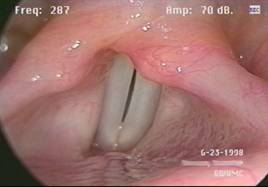

Figure 1. (a) Normal vocal fold. (b) Vocal fold with stroke induced unilateral paralysis.
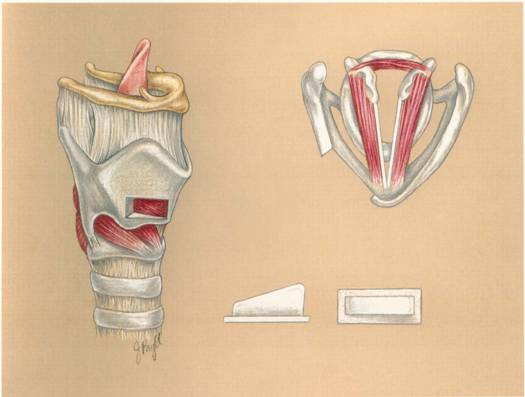
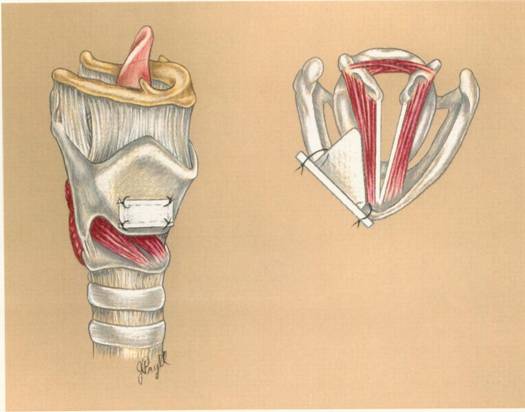
Figure 2. Schematic depicting the medialization laryngoplasty procedure (a) Thyroplasty window and implant shape. (b) Medialization induced by implantation.

Figure 3. Development of patient-specific model from thin-cut CT scans. Figure shows three views of the laryngeal CT scan and bottom right shows the airway lumen extracted from CT.

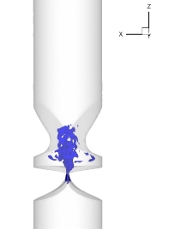

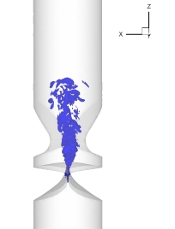
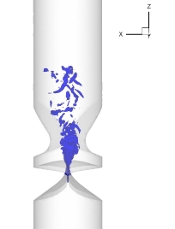
Figure 4. Computer simulations of phonation for a simplified model based on a CT scan. Figure shows one cycle of vocal fold vibration and the formation of the glottal jet (shown as blue isosurfaces).